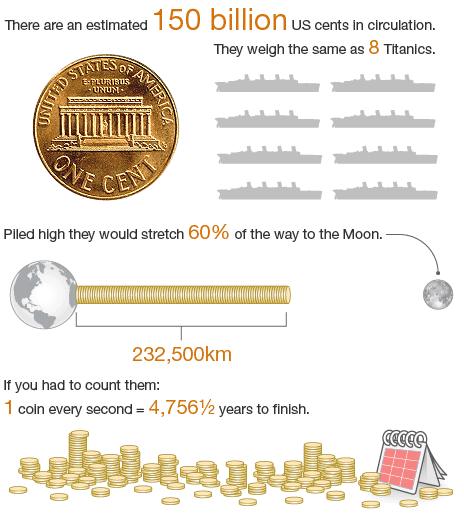The US penny: Should it be scrapped?
- Published
- comments

Canada has stopped producing the penny coin, deeming it a waste of money. The move has re-ignited a long-running debate in the US over the future of its single cent, and the question is sometimes raised in the UK too. So is it time to ditch the penny?
"No pennies here," reads a large sign with a big red slash through the middle, at the entrance to Shell Lumber, a busy hardware store in Miami, Florida.
A few weeks ago, its owner Andy Haase decided he had had enough.
"Every second counts - we were just wasting money and losing time," he says, referring to the time his staff spent counting pennies cashing up.
All cash purchases are now rounded down to the nearest nickel (5 cents) in favour of the customer. This eats into profits a little, but is more than offset by the time spent in labour counting them, says Haase.

No pennies please: Jim Turner at his campground, and the sign that greets customers to Shell Lumber
It is the same story at the KOA campsite in Estes Park, Colorado, which has been operating a "penniless policy" since 2007.
"This is just a silly coin to have," says owner Jim Turner. "Customers think it's a great idea - no one has ever complained."
It's a "total no-brainer", says Jeff Gore, a physics professor at Massachusetts Institute of Technology (MIT), who has spent 10 years lobbying for the US to get rid of the penny, and heads up the group Citizens for Retiring the Penny.
"At least something is happening somewhere," he says, referring to the recent move by the Canadian government, "and that gives us hope".
In May, Royal Canadian Mint struck its final one-penny piece, sending it off to a museum.
Explaining the move, the Canadian Finance Minister, Jim Flaherty, said the one-cent coin had become "a currency without currency", a coin which now has little value, and little use - and a <link> <caption>majority of Canadians </caption> <url href="http://patmartin.ndp.ca/post/most-canadians-favour-scrapping-penny-poll" platform="highweb"/> </link> were behind him.
The financial equation did not add up either. Each penny was costing 1.6 Canadian cents to produce and distribute, meaning a net loss to the government of C$11m ($10.7m, £6.9m) per year.
The case for ditching the US cent appears, on the surface at least, to be even stronger. A penny - as it is commonly known in the US - costs 2.4 cents to produce and distribute. And there were 4.3 billion minted lasted year.
"Every penny minted represents a loss for tax payers," says Francois Velde, an economist at the Federal Reserve Bank of Chicago, and co-author of The Big Problem of Small Change.
There are many precedents. The US has abolished a number of coins in the past, including the half cent in 1857. The UK's halfpenny ($0.8 cents) was withdrawn in 1984.
New Zealand and Australia abandoned the one-cent and two-cent coin in the 1990s. (New Zealand later ditched the five-cent coin too.)
"The penny has become a meaningless token, it serves no purpose whatsoever," says Velde.
"Pennies are like counters in a silly game, just to make up a certain number."
According to the US General Accounting Office, <link> <caption>two-thirds of pennies are out of circulation</caption> <url href="http://www.gao.gov/products/T-GGD-96-153" platform="highweb"/> </link> , with many of them disappearing almost the moment they reach the public.
Billions are stashed away in penny jars or piggy banks, many are lost - some are even thrown away.
But the little penny has some staunch defenders.
Prices would inevitably be rounded up, not down, says Mark Weller of Americans for Common Cents, a pro-penny lobby group.
"It would negatively impact on working families… We're proud to be standing up for the little guy," he says.
"Some may question the value of the penny, but collectively it's very valuable," adds Weller citing a number of examples of charities which have raised millions from pennies.
And polls consistently suggest a majority of the US public is in favour of keeping the coin.
"People gripe and moan about the penny, but they still want to keep it," says Richard Doty, senior curator of the Numismatic Collection at the National Museum of American History in Washington, DC.
For the last four years, the museum has been inviting visitors to vote with a penny on whether they want to keep the one cent or get rid of it.
They used to get their interns to count every penny-vote cast, but stopped when they topped the one million mark, and now just "eyeball it".
Their poll suggests the public is split, around 60/40 in favour of retaining the penny.
"Money has a value way beyond the simple amount it is worth in exchange - it has an almost mythic or religious quality," says Doty.
"People don't want to mess with tradition… They will keep a coin even though it's not worth anything, or makes no sense."
Since 1909, over 100 years, the US penny has borne the portrait of Abraham Lincoln, the much-respected president who led the country through the civil war. Though Lincoln is also represented on the $5 bill, many object to losing a denomination which honours his memory.
There have been two attempts to get Congress to abolish the penny (in 2002 and 2006), but neither was successful. The penny debate even featured in an episode of the US television series, The West Wing.
In the UK it is less of a political issue, but there are sporadic calls in the media for the coin to go.
<link> <caption>One study in the UK</caption> <url href="http://www.visaeurope.com/deliverpdf.aspx?pageId=277" platform="highweb"/> </link> suggested that 10% of men admit to getting so annoyed by pennies, they bin them in so-called "penny rage".
"People pick on the penny unnecessarily," says Phil Mussell, director of the UK-based publication Coin News.
He finds talk of getting rid of the penny "slightly irritating", and invokes the "sheer weight of history" as an argument for keeping it.
The first US penny was made in 1793, and the British penny dates back way before this.
"King Offa was the chap who first introduced the penny in 789 AD," says Mussell. "It was the only coin in existence in England for about 500 years… it's our oldest unbroken coin."
He doesn't think abolition will happen. "The British are very proud of their traditions. I do believe the vast majority of people would be up in arms."
"We are probably more likely to see the end of coinage in general, than we are the penny," says Mussell.
The UK penny, and the euro cent for that matter, have one big advantage over the US penny - both cost less than face value to produce.
Most coppers are no longer actually made of copper. As the price of copper rose, mints around the world looked for alternatives.
The UK penny, and euro cent, are made from steel, with a copper-plating.
The US penny is made mostly of zinc - a more expensive metal. In 2010, Congress ordered a review of the composition of small coins, which is due by December at the latest.
They will also no doubt be considering the following conundrum - the nickel (5 cents) also comes in well above face value, at 11.18 cents per coin.
If there were no pennies, more nickels would have to be made - and <link> <caption>according to some studies</caption> <url href="http://financialservices.house.gov/UploadedFiles/HHRG-112-BA19-WState-RBosco-20120417.pdf" platform="highweb"/> </link> , this would result in an even greater net loss than the status quo.